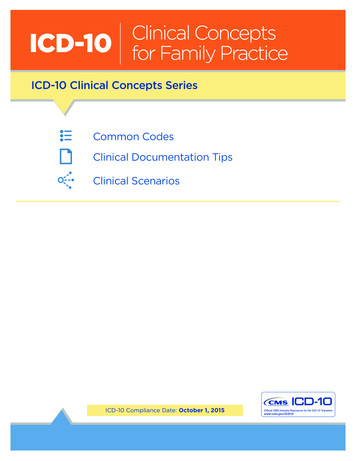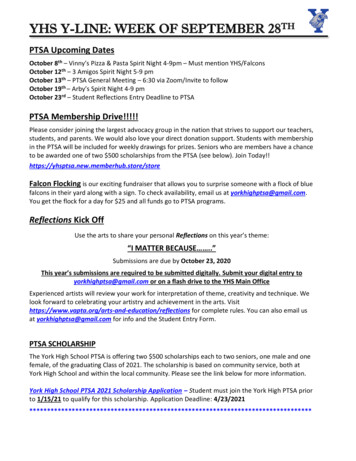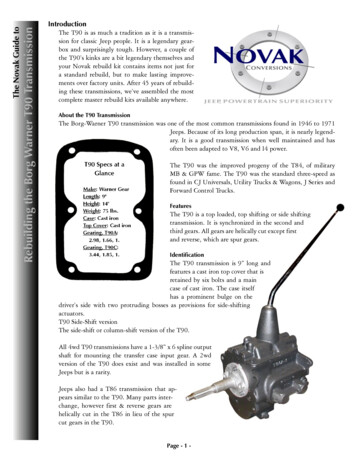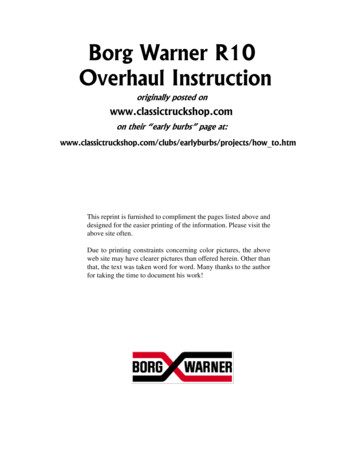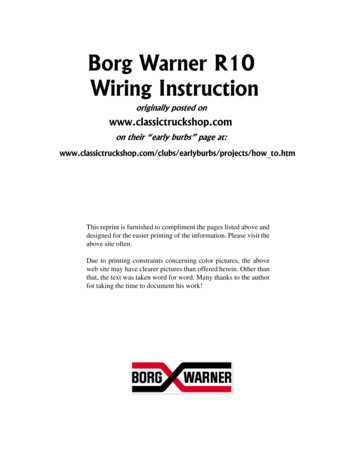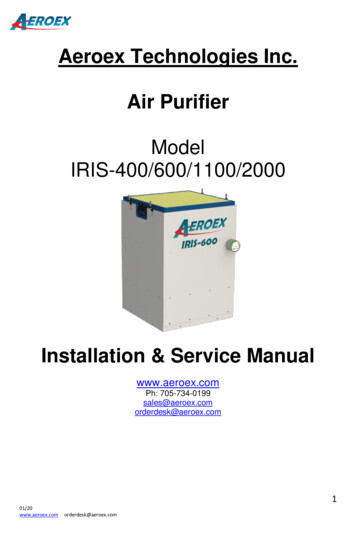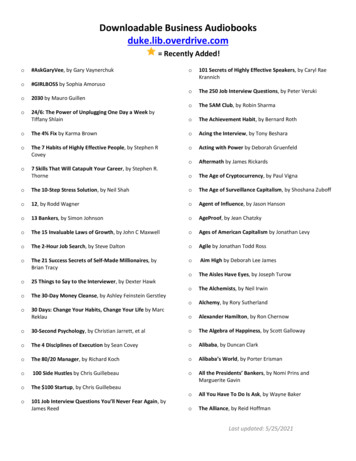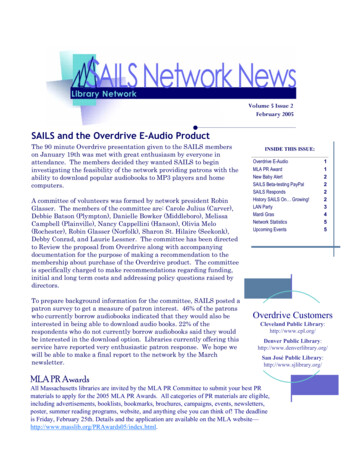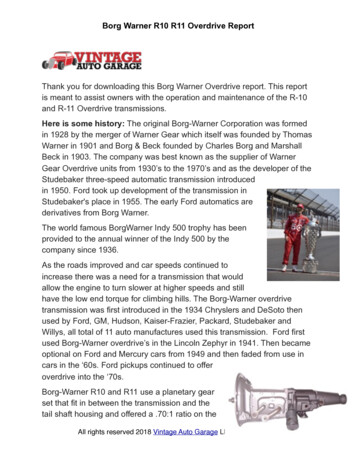
Transcription
Borg Warner R10 R11 Overdrive ReportThank you for downloading this Borg Warner Overdrive report. This reportis meant to assist owners with the operation and maintenance of the R-10and R-11 Overdrive transmissions.Here is some history: The original Borg-Warner Corporation was formedin 1928 by the merger of Warner Gear which itself was founded by ThomasWarner in 1901 and Borg & Beck founded by Charles Borg and MarshallBeck in 1903. The company was best known as the supplier of WarnerGear Overdrive units from 1930’s to the 1970’s and as the developer of theStudebaker three-speed automatic transmission introducedin 1950. Ford took up development of the transmission inStudebaker's place in 1955. The early Ford automatics arederivatives from Borg Warner.The world famous BorgWarner Indy 500 trophy has beenprovided to the annual winner of the Indy 500 by thecompany since 1936.As the roads improved and car speeds continued toincrease there was a need for a transmission that wouldallow the engine to turn slower at higher speeds and stillhave the low end torque for climbing hills. The Borg-Warner overdrivetransmission was first introduced in the 1934 Chryslers and DeSoto thenused by Ford, GM, Hudson, Kaiser-Frazier, Packard, Studebaker andWillys, all total of 11 auto manufactures used this transmission. Ford firstused Borg-Warner overdrive’s in the Lincoln Zephyr in 1941. Then becameoptional on Ford and Mercury cars from 1949 and then faded from use incars in the ‘60s. Ford pickups continued to offeroverdrive into the ‘70s.Borg-Warner R10 and R11 use a planetary gearset that fit in between the transmission and thetail shaft housing and offered a .70:1 ratio on theAll rights reserved 2018 Vintage Auto Garage LLC 800-516-4461
Borg Warner R10 R11 Overdrive ReportR10 and .72:1 on the R-11. Overdrive was available in second and thirdgear, essentially offering five forward speeds. These transmissions areelectro- mechanical and requires several electrical components as follows:Solenoid, Governor, Kick Down Switch and Relay and all wired togetherusing a wiring harness.The R-10 has a three pinion planetary gear set and adequate for moststreet applications, the R-11 uses a four pinion planetary gear set andoverall a stronger transmission.Operating the overdrive is simple. There is a manual control cablemounted under the dash and used by the driver to manually engage thetransmission. Pulling the handle out takes the transmission out of overdriveand then operates like a conventional three speed. Pushing the handle inengages the overdrive.Driving a car with overdrive requires the driver to understand the operationand may require some adjustment in driving style. With the overdriveengaged handle in, the transmission will freewheel below 20-32 mphdepending on the car’s rear end gearing, which means the engine will drivethe wheels, when you lift off the throttle the wheels won’t spin the enginethe car will coast as there is no engine braking. However, once the car is upto the required miles per hour about (23 MPH) the governor closes theelectrical circuit, then when the driver momentarily releases the throttle thesolenoid locks the sun gear of the planetary set and the transmission shiftsinto overdrive which also means there will be compression braking whenyou let off the gas.Shifting out of overdrive happens in two ways. Slowing down under thegovernor cut-in speed (23 MPH) causes the solenoid to release. Or, if thethrottle is floored the kick-down switch is activated. This does two things, itinterrupts power to the OD solenoid and also cut voltage to the ignitioncircuit momentarily. With power to the solenoid cut you would think it wouldrelease the sun gear and the transmission would revert to direct drive.However, with the transmission under load the solenoid shaft pin is trappedand can not be released, by shutting off the ignition system briefly releasesAll rights reserved 2018 Vintage Auto Garage LLC 800-516-4461
Borg Warner R10 R11 Overdrive Reportthe load on the solenoid shaft pin and allows the solenoid to release thesun gear (which means the transmission is in direct drive) and the ignitionsystem is back on and all this happens very fast.The governor activates around 23 MPH, this means the overdrive can notbe activated below this speed. Around above town in traffic using overdrivein second gear is like having an automatic as the transmission will shiftback and forth between direct and overdrive as the speed varies.On the highway and cruising in third gear the transmission is in overdrive.Then you want to pass another car, the driver simply stomp on the gaspedal and this will activate the kick down switch and causes a downshifttaking the overdrive out for passing.When parking and leaving the vehicle in overdrive there has been morethan one car known to roll away. Most transmissions had an internalmechanism to lock out the overdrive in reverse, which would keep this fromhappening. The only other way to keep the car from rolling in any othergear was to disengage the overdrive by pulling out the OD handle andmake sure the parking brake is set.Reversing the vehicle with OD engage will damage the internal gears andbearing in the OD and will be very costly. It is never recommendedbypassing the reverse lock out circuitNow that we covered overdrive basics, we will dig further into somespecifics around the OD electrical system. We mentionedearlier that 11 car manufactures installed the BorgWarnerR10-R11 transmissions and essentially all electricaloperation is the same. However, all companies useddifferent colored wires making it hard to troubleshoot andchange parts. Click here to see wire diagramThe purpose of the solenoid is to engage the Overdrive byextending the shaft and locking the sun gear.Solenoid shaft lengths: most but not all measure about 1” in length. Thereare a few exceptions, station wagons and convertibles had 1 1/2 inch longAll rights reserved 2018 Vintage Auto Garage LLC 800-516-4461
Borg Warner R10 R11 Overdrive Reportshaft due to an extra cross member present on the frame and someChevrolet pickups from the mid to late 1960's had a 2” long shafts. Theimage shows solenoid with 1” shaft length.The two most common components that wear out on a Borg Warneroverdrive transmission is the Relay and the Solenoid, as they are used themost. The 6 volt and 12 volt solenoid and relay are not interchangeable. Ifyou need to replace, you will need to order the one thatmatches your electrical system voltage.Kick down switches are the next most commoncomponent to wear and will indeed work on both 6volts or 12-volts.Governors seldom go bad or need replacing and willwork on either 6 volt or 12 volts.Solenoid wire terminal locations: To correctly locate the terminal on thesolenoid follow this: With the solenoid in hand and the shaft facing awayfrom you, the right hand terminal is #4 and will connect to the relay. The lefthand terminal #6 connects to the kick down switch. A few solenoids had athird wire which was a ground but in most solenoids the case itself is theground. A few solenoids had internal connections with wires coming out ofthe solenoid. Wiring connections for both are the same, you will just needto check which wire is the #4 and #6 by activating the solenoid with voltageand grounding the case.#4Case is theground.#6All rights reserved 2018 Vintage Auto Garage LLC 800-516-4461
Borg Warner R10 R11 Overdrive ReportThere were two solenoid manufactures besides Borg Warner which wereAutolite and Delco. Both of these will interchange as long as the shaftlength matches and the operating voltage is correct with your vehicle.Checking Solenoids for operation: The best way to test a solenoid is toapply battery power directly to the #4 terminal and grounding the case witha set of jumper cables or test leads. Whentouching the ground, the solenoid shaft shouldsnap out. You can do this while the solenoid isin the vehicle or on the bench. Either wayshould make the solenoid work. A 6 voltsolenoid will operate on 12 volts, but this doesnot mean you have a 12 volt solenoid as the 6volt coils will indeed work on 12 volts for awhile. But a 12 volt solenoid will not operate on 6 volts. Be careful whenbuying used solenoids in the open market, you may not be buying a 12 voltsolenoid and you may get a 6 volt solenoid and find that it fails after a shorttime on 12 volts.Solenoid Installation: first, always replace the seal inthe transmission housing, if your seal is bad, oil willleak into the solenoid and damage the solenoid.When you get ready to install the solenoid you want toline up the solenoid shaft so the flat spot is at the 12o’clock. Next apply battery power to the number #4terminal on the solenoid and ground the case of the solenoid which willextend the shaft out. Next carefully slide the solenoid shaft past the seal,you should apply a little white grease or Vaseline in the center of the sealand on the end of the solenoid shaft, this allows the shaft to slide in easier.Slide shaft in until the shaft engages into the pawl in the transmission.Once it is engaged turn the solenoid to secure the pawl into the grove ofthe solenoid and align the bolt holes. Next start the bolts loosely to align tohousing, now release the power and the solenoid shaft should retract, ifAll rights reserved 2018 Vintage Auto Garage LLC 800-516-4461
Borg Warner R10 R11 Overdrive Reportyou have the pawl into the groove at the end of the solenoid shaft correctlythe solenoid itself will be pulled towards the transmission housing, thentighten the bolts. If you follow this procedure you can be certain thesolenoid is installed correctly.This procedure also works if the flat spot on the solenoid shaft is clocked ata different location than the original. The rule is, you want the flat spot onthe shaft to be at 12 'clock position when you insert the shaft into thetransmission. Once the pawl is in the groove rotate the solenoid asnecessary to line up the mounting holes.Wiring your overdrive: Below is a typical wiring diagram thatshows how the OD electrical components are connected.Each auto manufacture used there own color codes on thewires but they were all wired essentially the same way.When converting from 6 volts to 12 volts and changing frompositive to negative ground, there is no changes needed tothe wiring harness. If you need a new wiring harness clickthis link.All rights reserved 2018 Vintage Auto Garage LLC 800-516-4461
Borg Warner R10 R11 Overdrive ReportOverdrive relay: There are 2 styles of relays, first image below isreproduction of the original style relay with external fuse. The second relayuses a modern style relay with self setting internal fuse in a water tightcase. Both work the same way but we find the second relay is simpler toinstall with well marked connection terminal screws and like the watertightcase.Servicing and cleaning your overdrive: If your OD has not been serviceproperly and has 50 year old lubricant, here is a simple way to cleanwithout tearing the OD apart. Drain the fluid in the OD, replace the plug andfill the OD with kerosene. Start the engine and run the transmission forabout 5-10 minutes then drain the dirty kerosene and refill with the correctoverdrive transmission fluid. Use only API rated GL-1 oilDo not use any synthetic gear oils.The sulfur and related additives inmodern lubricants will destroy the bronze parts inside of the Borg-Warneroverdrive. Most all Borg-Warner manual overdrive transmissions requirefour pints of lubricant. Dirty OD transmissions are a primary cause of ODoperation problems.Click this link for more partsWe hope this report answered questions you may have had.Thank you!All rights reserved 2018 Vintage Auto Garage LLC 800-516-4461
Borg Warner R10 R11 Overdrive ReportAll rights reserved 2018 Vintage Auto Garage LLC 800-516-4461
Borg Warner R10 R11 Overdrive Report Overdrive relay: There are 2 styles of relays, first image below is reproduction of the original style relay with external fuse. The second relay uses a modern style relay with self setting internal fuse in a water tight case. Both work the same way but we find the second relay is simpler to
